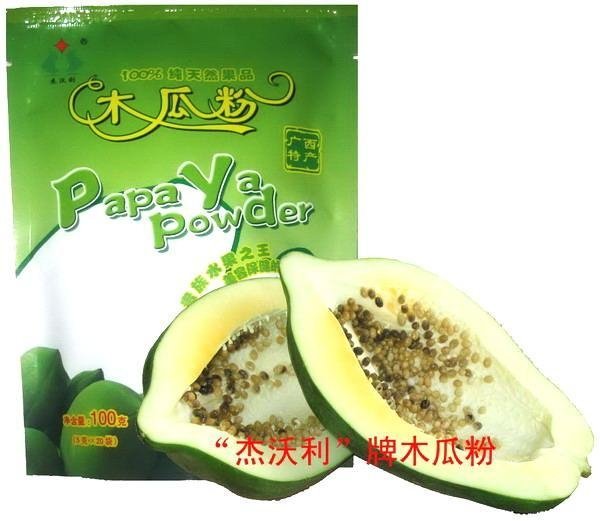
A Delicious, Healthy, Body-shaping, and Fashionable Fruit Dish
【Product Introduction】
“Javely Papaya Powder” is processed by carica papaya - tropical fruit found specifically in Guangxi. The fruit contains rich nutrient elements such as papaya leaven, papain, chymopapain, carotene, protein, fructose, iron, calcium, phosphorus, and vitamin C, as well as at least 17 different amino acids. It is not only the nutritious “treasure among fruits” but also a traditional recipe for nursing mother.

【Product Features】

As we can see the uses for papain are diverse and thus it makes it an extremely valuable enzyme. Papain has been employed to treat ulcers, dissolve membranes in diphtheria, and reduce swelling, fever and adhesions after surgery. With considerable risk, it has been applied on meat impacted in the gullet. Chemopapain is sometimes injected in cases of slipped spinal discs or pinched nerves. Precautions should be taken because some individuals are allergic to papain in any form and even to meat tenderized with papain. In tropical folk medicine, the fresh latex is smeared on boils, warts and freckles and given as a vermifuge. In India, it is applied on the uterus as an irritant to cause abortion. The unripe fruit is sometimes hazardously ingested to achieve abortion. Seeds, too, may bring on abortion. They are often taken as an emmenagogue and given as a vermifuge. The root is ground to a paste with salt, diluted with water and given as an enema to induce abortion. A root decoction is claimed to expel roundworms. Roots are also used to make salt. Crushed leaves wrapped around tough meat will tenderize it overnight. The leaf also functions as a vermifuge and as a primitive soap substitute in laundering. Dried leaves have been smoked to relieve asthma or as a tobacco substitute. Packages of dried, pulverized leaves are sold by "health food" stores for making tea, despite the fact that the leaf decoction is administered as a purgative for horses in Ghana and in the Ivory Coast it is a treatment for genito-urinary ailments. The dried leaf infusion is taken for stomach troubles in Ghana and they say it is purgative and may cause abortion. Studies at the University of Nigeria have revealed that extracts of ripe and unripe papaya fruits and of the seeds are active against gram-positive bacteria. Strong doses are effective against gram-negative bacteria. The substance has protein-like properties. The fresh crushed seeds yield the aglycone of glucotropaeolin benzyl isothiocyanate (BITC) which is bacteriostatic, bactericidal and fungicidal. A single effective does is 4-5 g seeds (25-30 mg BITC). In a London hospital in 1977, a post-operative infection in a kidney-transplant patient was cured by strips of papaya which were laid on the wound and left for 48 hours, after all modern medications had failed.


